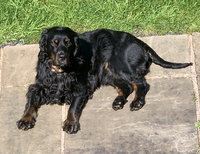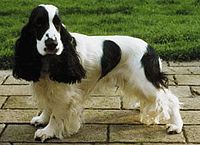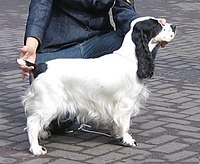English Cocker Spaniel
| English Cocker Spaniel | |||||||||||||
|---|---|---|---|---|---|---|---|---|---|---|---|---|---|
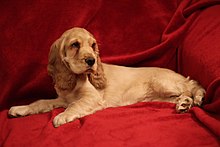 Red English Cocker Spaniel | |||||||||||||
| Other names | Cocker Spaniel | ||||||||||||
| Common nicknames | Cocker, Cocker Spaniel | ||||||||||||
| Origin | England | ||||||||||||
| |||||||||||||
| Dog (domestic dog) | |||||||||||||
The English Cocker Spaniel is a breed of gun dog. It is noteworthy for producing one of the most varied numbers of pups in a litter among all dog breeds. The English Cocker Spaniel is an active, good-natured, sporting dog[1] standing well up at the withers and compactly built.[2] There are "field" or "working" cockers and "house" cockers. It is one of several varieties of spaniel and is the foundation of its American cousin, the American Cocker Spaniel. The English Cocker is closer to the working-dog form of the Field Spaniel and the English Springer Spaniel. English Cocker Spaniels are also known as the "Merry Spaniel" due to their constantly wagging tail.
Outside the US, the breed is usually known simply as the Cocker Spaniel, as is the American Cocker Spaniel within the US. The OED states that the word cocker is derived from the fact the breed was used to flush woodcocks.[3]
History
[edit]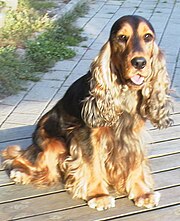

Spaniel type dogs have been found in art and literature for almost 500 years.[4][better source needed] Initially, spaniels in England were divided among land spaniels and water spaniels. The differentiation among the spaniels that led to the breeds that we see today did not begin until the mid-19th century. During this time, the land spaniels became a bit more specialised and divisions among the types were made based upon weight. According to the 1840 Encyclopedia of Rural Sports, Cockers were 12–20 lb (5.5–9 kg).[4][better source needed] At this time it was not uncommon for Cockers and Springers to come from the same litter. Even a puppy from a "Toy" sized lineage could grow to be a springer.[4][better source needed]
There is no indication from these early sources that spaniels were used to retrieve games. Rather they were used to drive the game toward the guns.[4][better source needed]
During the 1850s and 1860s, other types of Cockers were recorded. There were Welsh Springer Spaniels and Devonshire Cockers. Additionally, small dogs from Sussex Spaniel litters were called Cockers.[4][better source needed] In 1874 the first stud books were published by the newly formed kennel club. Any spaniel under 25 lb (11 kg) was placed in the Cocker breeding pool, however, the Welsh Cocker was reclassified as a Springer in 1903 due to its larger size and shorter ear.[4] [better source needed]"...in those days only those dogs up to a hard day's work and sensible specimens were allowed to live, as absolute sporting purposes were about their only enjoyment and dog shows were hardly heard of...".[4][better source needed]
The sport of conformation showing began in earnest among spaniels after the Spaniel Club was formed in 1885. When showing, the new Springer and Cocker, both were in the same class until The Spaniel Club created breed standards for each of the types. The Kennel Club separated the two types eight years later. Since then, the Springer and Cocker enthusiasts have bred in the separate traits that they desired. Today, the breed differs in more ways than weight alone.[citation needed]
At Crufts, the English Cocker Spaniel has been the most successful breed in winning Best in Show, winning on a total of seven occasions between 1928 and 2009, with wins in 1930, 1931, 1938, 1939, 1948, 1950 and 1996. In addition, the breed makes up three of the four winners who have won the title on more than one occasion with all three coming from H. S. Lloyd's Ware kennel. Due to World War II, the English Cocker Spaniel managed to be the only breed to have won the title between 1938 and 1950, although the competition was only held on four occasions during that period. The most recent best in show was Sh. Ch. Canigou Cambrai in 1996.[5][6]

Field Spaniel
[edit]In the late 19th century with the increase in popularity of dog shows and the creation of standards for various breeds, the Spaniel family began to split into various different breeds. A group of enthusiasts decided to create a large black spaniel breed. Four dogs would act as progenitors for this new breed, of which two were Cocker Spaniels, one was a Cocker Spaniel/English Water Spaniel cross and one was a Norfolk Spaniel. This new breed was named the Field Spaniel, and was recognised by the Kennel Club in 1892.[citation needed]
American Cocker Spaniel
[edit]
The American Cocker Spaniel was developed from the English Cocker Spaniel in the 19th century to retrieve quails and woodcocks. They were originally divided from the English Cocker solely on a size basis but were bred over the years for different specific traits.[citation needed] The two Cocker Spaniels were shown together in America until 1936, when the English Cocker received status as a separate breed. The American Kennel Club granted a separate breed designation for the English Cocker Spaniel in 1946.[2] The American breed has a shorter snout and is groomed differently from the English Cocker.[citation needed]
Description
[edit]The English Cocker Spaniel is a sturdy, compact and well-balanced dog. It has a characteristic expression showing intelligence and alertness. Its eyes should be dark and its lobular ears should reach "a bit past" the tip of the nose when pulled forward.[2] Today, a significant difference in appearance exists between field-bred and conformation show-bred dogs.[citation needed] The Cocker's tail is customarily docked in North America.[2] In countries where docking is legal, the tail is generally docked at about 4–5 inches (10–13 cm) in field-bred dogs while show dogs are generally docked closer to the body.[citation needed] Docking is now illegal in Australia[7] and South Africa.[citation needed] In England and Wales, docking can only be carried out on dogs where the owners have proved that the dogs will be used as working or shooting dogs.[8]
The breed standard indicates that the males of the breed are on average between 15.5 and 16 inches (39 and 41 cm) at the withers with the females a little smaller, growing to between 15 and 15.5 inches (38 and 39 cm). Both males and females of the breed weigh approximately 13–14.5 kilograms (29–32 lb).[9] American Cocker Spaniels are smaller, with males being on average between 14.25 and 15.5 inches (36.2 and 39.4 cm) and females again being smaller on average at between 13.5 and 14.5 inches (34 and 37 cm), both weighing approximately 11–13 kilograms (24–29 lb).[9]

The English Cocker Spaniel is similar to the English Springer Spaniel and at first glance, the only major difference is the larger size of the Springer. However, English Cockers also tend to have longer, and lower-set ears than English Springers. In addition Springers also tend to have a longer muzzle, their eyes are not as prominent and the coat is less abundant.[10]
Colour
[edit]
The breed standard of the United Kingdom's Kennel Club states that in solid colours, no white is allowed except for a small amount on the chest[9] and the American Kennel Club has standards for features including the expression, neck, topline, and body.[11] In working Cockers, breeders value working ability over the colour of the dog.[citation needed]
Solid English Cocker colours can come in black, liver/brown, red/golden with black or brown pigmentation[12] and Parti-coloured cockers come in blue roan, liver roan, orange roan with black or brown pigmentation, lemon roan with black or brown pigmentation, black and white ticked, liver and white ticked, orange and white ticked with black or brown pigmentation, lemon and white ticked with black or brown pigmentation,[13] black and white, liver and white with brown pigmentation, orange and white with black or brown pigmentation, lemon and white with black or brown pigmentation.[14] All of these colours can also have Tan-points.[citation needed]
Of the solid colours, sable is considered rare and controversial and is classified by some countries as being a type of parti-colour on account of its mixed hair shafts.[citation needed] While some have claimed this colour is from a cross with a different breed[who?], geneticists[which?] have discovered English Cocker sable is unique to this breed.[15] In addition, a silver/ash colour, usually associated with the Weimaraner dog, is considered genetically possible but is yet to be recorded by the United Kingdom's Kennel Club.[16] Of the roan varieties, lemon roan with a light brown pigmentation is the most recessive of all the roans.[13] Plain white Cockers are rarely born and not encouraged in the breed.[14]
-
Black
-
Black and tan
-
Another black and tan
-
Liver Roan
-
A black and white cocker
-
Dark Blue Roan
-
A light Blue Roan and Tan English Cocker Spaniel
-
Black and White
-
Orange and white Cocker Spaniel
-
Blue roan Cocker Spaniel
-
Young Blue Roan Working Strain English Cocker Spaniel
Temperament
[edit]
The English Cocker Spaniel ranks 18th in Stanley Coren's The Intelligence of Dogs, being of excellent working/obedience intelligence.[17]
With a good level of socialisation at an early age, Cocker Spaniels can get along well with people, children, other dogs and other pets.[18] This breed seems to have a perpetually wagging tail and prefers to be around people; it is not best suited to the backyard alone. Cockers can be easily stressed by loud noises and by rough treatment or handling. When trained with a soft hand and plentiful rewards, the Cocker Spaniel will be an obedient and loving companion with a happy, cheerful nature.[19]
Health
[edit]
A 2022 UK study of veterinary clinic data found a life expectancy of 11.31 years slightly above the 11.21 overall average but below the 11.82 average for crossbreeds.[20] A 2024 UK study found a life expectancy of 13.3 years for the breed compared to an average of 12.7 for purebreeds and 12 for crossbreeds.[21] A 2024 Italian study found a life expectancy of 13 years for the breed compared to 10 years overall.[22]
A 1996 study made by the University of Cambridge surveying 932 English Cocker Spaniel households throughout Britain found owners to report higher aggression in different coloured English Cocker Spaniels depending on the scenario.[23][24] A 2009 study by Spanish researchers at the Autonomous University of Barcelona the study found that English Cocker Spaniels were more frequently produced to a referral clinic for aggression and that they had more impulsive attacks than other dogs.[24][25][26] However, the notion of 'cocker rage' has been dismissed as a myth.[27]
A review of 2,318 English Cocker Spainels attending veterinary care found the most common conditions to be: periodontal disease with 20.97% prevalence, otitis externa with 10.09% prevalence, obesity with 9.88% prevalence, anal sac impaction with 8.07% prevalence, diarrhoea with 4.87% prevalence, and aggression with 4.01% prevalence.[28]
The English Cocker Spaniel is predisposed to chronic hepatitis,[29] with one study finding the breed to be 2.78 times more likely to acquire the disease.[30]
The English Cocker Spaniel is one of the more commonly affected breeds for progressive rod-cone degeneration. An autosomal recessive mutation in the PRCD gene is responsible for the condition in the breed.[31]
Working Cockers
[edit]
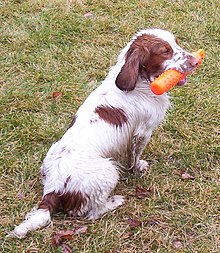
This breed, like many others with origins as working dogs, has some genetic lines that focus on working-dog skills and other lines that focus on ensuring that the dog's appearance conforms to a breed standard; these are referred to as the "working" (or "field-bred") and "conformation" strains, respectively. After World War II, Cocker Spaniels bred for pets and for the sport of conformation showing increased enormously in popular appeal, and, for a while, was the most numerous Kennel Club registered breed. This popularity increased the view that all Cockers were useless as working dogs.[32] However, for most dogs this is untrue, as even some show-bred Cockers have retained their working instinct.[33]
Today, this breed is experiencing a resurgence in usage as a working and hunting dog. Dogs from working lines are noticeably distinct in appearance. As is the case with the English Springer Spaniel, the working type has been bred exclusively to perform in the field as a hunting companion. Their coat is shorter and ears less pendulous than the show-bred type. Although registered as the same breed, the two strains have diverged significantly enough that they are rarely crossed.[32] The dogs that have dominated the hunt test, field trial and hunting scene in the United States are field-bred dogs from recently imported English lines.[34] Working-dog lines often have physical characteristics that would prevent them from winning in the show ring. This is a result of selecting different traits than those selected by show breeders. The longer coat and ears, selected for the show ring, are an impediment in the field.[2] Cuban authorities train and use English Cocker Spaniels as sniffer dogs to check for drugs or food products in passengers' baggage at Cuban airports.[35]
Skills
[edit]A field-bred cocker spaniel is first and foremost an upland flushing dog. In performing this task there are some skills the dog must be trained to perform.
- Hup This is the traditional command to sit and stay. To be an effective hunter the dog must comply with this command absolutely. When this command is given, the dog can be given directions called to the handler. The ability to hup a dog actively working a running bird allows the handler and any gunners to keep up without having to run.
- Retrieve to Hand The majority of hunters and all hunt test or field trial judges require that a dog deliver a bird to hand, meaning that a dog will hold the bird until told to give it to the hunter directly.
- Quarter Dogs must work in a pattern in front of the hunter seeking upland game birds. The dog must be taught to stay within gun range to avoid flushing a bird outside of shooting distance.
- Follow Hand Signals Upland hunting involves pursuing wild game in its native habitat. Gun dogs must investigate likely covers for upland game birds. The dog must be responsive to hand signals in order for the hunter to be able to direct the dog into areas of particular interest.
- Steady When hunting upland birds, a flushing dog should be steady to wing and shot, meaning that he sits when a bird rises or a gun is fired. He does this in order to mark the fall and to avoid flushing other birds when pursuing a missed bird.
In literature and film
[edit]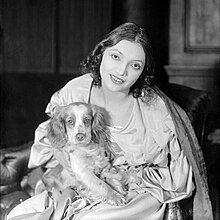
Elizabeth Barrett Browning wrote two poems to her red cocker spaniel Flush, To Flush, My Dog and Flush or Faunus.
The 1930 play The Barretts of Wimpole Street by the Dutch/English dramatist Rudolf Besier also had Browning's red cocker spaniel as a central character. The play was adapted to two film versions in 1934 and 1957, a musical (Robert and Elizabeth), and a 1982 TV film The Barretts of Wimpole Street made by the BBC.
Flush: A Biography is a semi-fictional biography of Elizabeth Barrett's red cocker spaniel written by Virginia Woolf and published in 1933.
Jasper is a cocker spaniel which features in the 1938 Daphne du Maurier novel Rebecca.
An English cocker is prominently featured in several episodes of James Herriot's All Creatures Great and Small.
An English cocker spaniel named Frisky is featured in the TV show Bluey. Frisky, who is voiced by Claudia O'Doherty, is depicted as Bluey's fairy godmother.
See also
[edit]References
[edit]- ^ Coile, D. Caroline (25 November 2006). The Cocker Spaniel Handbook. B.E.S. Publishing. ISBN 9780764134593 – via Google Books.
- ^ a b c d e "American Kennel Club: English Cocker Spaniel". Archived from the original on 19 August 2012. Retrieved 5 September 2009.
- ^ "Cocker etymology". Oxford English Dictionary. Oxford University. Retrieved 24 February 2024.
- ^ a b c d e f g Kolehouse, Bobbie. "Dusting off History to Look at Cocker Hunting Tradition Part I". Spaniel Journal. Retrieved 13 September 2009.
- ^ "Past and Present Winners". Crufts. Retrieved 24 February 2024.
- ^ "Besti hundur sýningar á Crufts, frá árunum 1928–2002" (in Icelandic). Hvuttar.net. Retrieved 28 December 2009.
- ^ "Is the tail docking of dogs legal in Australia?". Royal Australian Society for the Protection of Animals. Retrieved 19 February 2024.
- ^ "Defra, UK – Animal Health and Welfare". Archived from the original on 27 April 2009. Retrieved 9 September 2009.
- ^ a b c "The Cocker Spaniel Club: Breed Standard". The Kennel Club. Retrieved 13 September 2009.
- ^ Gormish, Denise. "A comparison of English Springer Spaniels, American Cocker Spaniels and English Springer Spaniels". English Cocker Spaniel Club of America. Archived from the original on 21 November 2010. Retrieved 13 September 2009.
- ^ "English Cocker Spaniel Dog Breed Information". American Kennel Club. Retrieved 1 February 2019.
- ^ Davis, Jinty Gill (9 September 2000). "Understanding Cocker Colours, Patterns and Markings Page 1". The Cocker Spaniel Club. Retrieved 7 January 2010.
- ^ a b Davis, Jinty Gill (9 September 2000). "Understanding Cocker Colours, Patterns and Markings Page 3". The Cocker Spaniel Club. Retrieved 7 January 2010.
- ^ a b Davis, Jinty Gill (9 September 2000). "Understanding Cocker Colours, Patterns and Markings Page 4". The Cocker Spaniel Club. Retrieved 7 January 2010.
- ^ "Genomia: Testing of dogs: Locus EH". genomia.cz. Retrieved 5 January 2019.
- ^ Davis, Jinty Gill (9 September 2000). "Understanding Cocker Colours, Patterns and Markings Page 2". The Cocker Spaniel Club. Retrieved 7 January 2010.
- ^ Stanley Coren. "The Intelligence of Dogs: Ranks 11 to 26". Archived from the original on 9 February 2010.
- ^ Coile, D. Caroline (2006). The Cocker Spaniel Handbook. Barron's Educational Series Inc. ISBN 978-0-7641-3459-3.
- ^ Coile (2006): p. 13
- ^ Teng, Kendy Tzu-yun; Brodbelt, Dave C.; Pegram, Camilla; Church, David B.; O’Neill, Dan G. (28 April 2022). "Life tables of annual life expectancy and mortality for companion dogs in the United Kingdom". Scientific Reports. 12 (1). Springer Science and Business Media LLC: 6415. Bibcode:2022NatSR..12.6415T. doi:10.1038/s41598-022-10341-6. ISSN 2045-2322. PMC 9050668. PMID 35484374.
- ^ McMillan, Kirsten M.; Bielby, Jon; Williams, Carys L.; Upjohn, Melissa M.; Casey, Rachel A.; Christley, Robert M. (1 February 2024). "Longevity of companion dog breeds: those at risk from early death". Scientific Reports. 14 (1). Springer Science and Business Media LLC. doi:10.1038/s41598-023-50458-w. ISSN 2045-2322. PMC 10834484.
- ^ Roccaro, Mariana; Salini, Romolo; Pietra, Marco; Sgorbini, Micaela; Gori, Eleonora; Dondi, Maurizio; Crisi, Paolo E.; Conte, Annamaria; Dalla Villa, Paolo; Podaliri, Michele; Ciaramella, Paolo; Di Palma, Cristina; Passantino, Annamaria; Porciello, Francesco; Gianella, Paola; Guglielmini, Carlo; Alborali, Giovanni L.; Rota Nodari, Sara; Sabatelli, Sonia; Peli, Angelo (2024). "Factors related to longevity and mortality of dogs in Italy". Preventive Veterinary Medicine. 225: 106155. doi:10.1016/j.prevetmed.2024.106155. hdl:11585/961937.
- ^ Podberscek AL & Serpell J A (1996) The English Cocker Spaniel: preliminary findings on aggressive behaviour. Applied Animal Behaviour Science 47: 75-89 cited by Linda Ward (2002). "Rage syndrome". Applied Animal Behaviour Science. Human-Animal Interactions. 47 (1). self-published: 75–89. doi:10.1016/0168-1591(95)01012-2.
- ^ a b Viegas, Jennifer (22 May 2009). "World's Meanest Dog: The English Cocker Spaniel?". Discovery News. Retrieved 13 September 2009.
- ^ Amat, Marta; Xavier Manteca; Valentina M. Mariotti; José Luís Ruiz de la Torre; Jaume Fatjó (May 2009). "Aggressive behavior in the English cocker spaniel". Journal of Veterinary Behavior: Clinical Applications and Research. 4 (3). Universitat Autònoma de Barcelona, Bellaterra: School of Veterinary Medicine: 111–17. doi:10.1016/j.jveb.2008.08.010. Retrieved 13 September 2009.
- ^ "What is Rage Syndrome?". The cocker spaniel club. Retrieved 8 June 2015.
- ^ Pacelli, Alessandra (21 July 2023). "The persistent myth of 'Cocker rage'". Dogs Today Magazine. Retrieved 15 September 2024.
- ^ Engdahl, Karolina S.; Brodbelt, Dave C.; Cameron, Carla; Church, David B.; Hedhammar, Åke; O’Neill, Dan G. (19 May 2023). "Demography and disorders of English Cocker Spaniels under primary veterinary care in the UK". Canine Medicine and Genetics. 10 (1). Springer Science and Business Media LLC: 4. doi:10.1186/s40575-023-00128-x. ISSN 2662-9380. PMC 10197368. PMID 37202773.
- ^ Bexfield, Nick (2017). "Canine Idiopathic Chronic Hepatitis". Veterinary Clinics of North America: Small Animal Practice. 47 (3): 645–663. doi:10.1016/j.cvsm.2016.11.012.
- ^ Bandara, Y.; Bayton, W. A.; Williams, T. L.; Scase, T.; Bexfield, N. H. (2021). "Histopathological frequency of canine hepatobiliary disease in the United Kingdom". Journal of Small Animal Practice. 62 (9): 730–736. doi:10.1111/jsap.13354. ISSN 0022-4510.
- ^ Oliver, James A.C.; Mellersh, Cathryn S. (2020). "Genetics". In Cooper, Barbara; Mullineaux, Elizabeth; Turner, Lynn (eds.). BSAVA Textbook of Veterinary Nursing (Sixth ed.). British Small Animal Veterinary Association. p. 131. ISBN 978-1-910-44339-2.
- ^ a b "Show Bred vs Working Cockers". Petwave.com. Archived from the original on 12 April 2018. Retrieved 5 September 2009.
- ^ Moxon, P.R. (1960s). "The Cocker Spaniel as a Gundog". Felsteadgundogs.com. Archived from the original on 9 June 2009. Retrieved 5 September 2009.
- ^ Thoms, Jerry (December 2002). "Pocket Rockets" (PDF). Gun Dog Magazine. Archived from the original (PDF) on 3 December 2007.
- ^ "Travel research, planning and reports: Cuba". Darshama.net. Archived from the original on 30 May 2011. Retrieved 5 September 2009.
Further reading
[edit]- Thoms, Jerry. "Emma is a Gun Dog (Cocker Size)". Gun Dog Magazine. Archived from the original on 19 April 2005.
- Roettger, Anthony. Urban Gun Dogs: Training Flushing Dogs for Home and Field, The Writer's Collective, 2004. ISBN 1-59411-050-6
- Sucher, Jamie (1999). Cocker Spaniels (Complete Pet Owner's Manuals). Hauppauge, NY: Barron's. ISBN 978-0-7641-1034-4.
- Grainger, Alexandra. Training your Cocker...Whilst Playing with Children. Complete Owner's Guide.
- Fergus, Charles. Gun Dog Breeds, A Guide to Spaniels, Retrievers, and Pointing Dogs, The Lyons Press, 2002. ISBN 1-58574-618-5
- Fogle, Dr Bruce. Cocker Spaniel English and American, Dorling Kindersley Limited, 1996.



